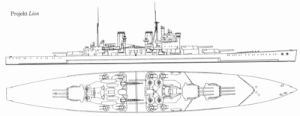 Right elevation and plan of the 1938 version of the Lion design
| |
| Class overview | |
|---|---|
| Name | Lion-class battleship |
| Operators | |
| Preceded by | King George V class |
| Succeeded by | HMS Vanguard |
| Planned | 6 |
| Completed | 0 |
| Cancelled | 6 |
| General characteristics (1938 design) | |
| Type | Fast battleship |
| Displacement | |
| Length | |
| Beam | 105 ft (32 m) |
| Draught | 33 ft 6 in (10.2 m) (deep load) |
| Installed power |
|
| Propulsion | 4 shafts; 4 × steam turbine sets |
| Speed | 30 knots (56 km/h; 35 mph) |
| Range | 14,000 nmi (26,000 km; 16,000 mi) at 10 knots (19 km/h; 12 mph) |
| Complement | 1,680 |
| Armament |
|
| Armour |
|
| General characteristics (1942 design) | |
| Displacement |
|
| Length |
|
| Beam | 108 ft (32.9 m) |
| Draught | 34 ft 3 in (10.4 m) (deep load) |
| Installed power |
|
| Propulsion | 4 shafts; 4 × steam turbine sets |
| Speed | 28.25 knots (52.32 km/h; 32.51 mph) |
| Range | 16,500 nmi (30,600 km; 19,000 mi) at 10 knots (19 km/h; 12 mph) |
| Complement | 1,750 |
| Armament |
|
| Armour |
|
The Lion class was a class of six fast battleships designed for the Royal Navy (RN) in the late 1930s. They were a larger, improved version of the preceding King George V class, with 16-inch (406 mm) guns. Only two ships were laid down before the Second World War began in September 1939 and a third was ordered during the war, but their construction was suspended shortly afterwards. The design was modified in light of war experience in 1942, but the two ships already begun were scrapped later in the year.
None of the other ships planned were laid down, although there was a proposal in 1941 to modify one of the suspended ships into a hybrid battleship-aircraft carrier with two 16-inch gun turrets and a flight deck. Preliminary work for a new design began in 1944 and continued for the next year or so until the RN realised that they were unaffordable in the post-war financial environment.